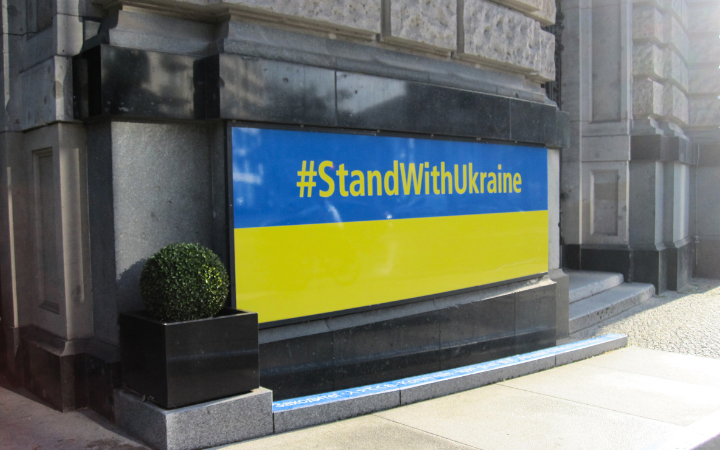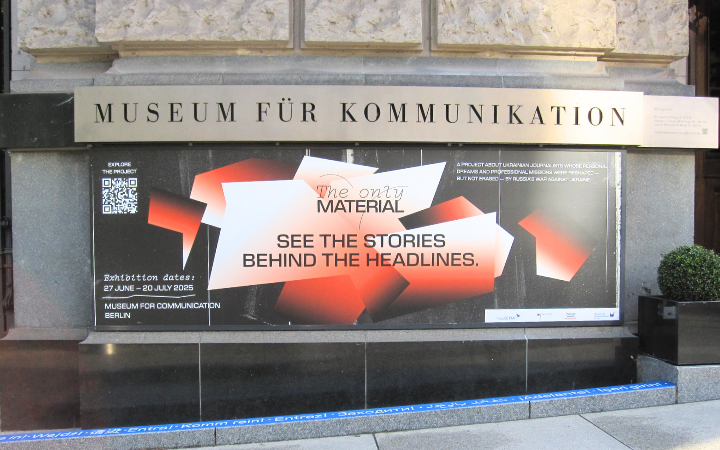On 26 June, the Museum of Communication in Berlin opened an exhibition entitled The Only Material, dedicated to the work of Ukrainian journalists during the war. The exhibition was organised by the European Centre for Press and Media Freedom as part of the Voices of Ukraine support programme, in cooperation with the Museum of Communication and with the support of the Hannah Arendt Initiative.

The exhibition explores how journalists adapt, resist and work under the pressure of war. Through testimonies and photographs, The Only Material offers a rare glimpse beyond the headlines — at the resilience, resistance and hope that underpin journalistic work in the context of a full-scale Russian invasion. The exhibition features stories from journalists Viktoriya Yermolayeva, Andriy Kramchenko, Oleksandr Kochura, Hanna Murlykina, Polina Vernyhor, Andriy Dubchak, Yuliya Surkova, Alina Yevych, Nataliya Nahorna, and Oleh Baturin.
Hanna Murlykina and Polina Vernyhor spoke at the opening, sharing their personal stories and professional experiences. Ukrainian jazz singer Hanna Hryniva also performed at the event, singing Ukrainian folk songs in her own arrangements.
Hanna Murlykina, editor-in-chief of the Mariupol publication 069.com.ua, spoke about her forced displacement due to the occupation of Mariupol, as well as the transformation of her journalistic practice — from promoting environmental initiatives to stories about loss and destruction. ‘It's hard to talk about your dream when you don't know what will happen to you tomorrow. I had to leave my home, and now our only goal is to stop the war and restore justice. My dream is to see the Ukrainian flag flying over Mariupol,’ she said.

Polina Vernyhor emphasised the importance of social journalism and the impossibility of remaining on the sidelines: "I am very tired of writing about the war, but do I have a choice? As a journalist, as a human being, how can I turn a blind eye to this? Keep talking about Ukraine, don't be silent, because we depend on you."
Dietrich Wolf Fenner, head of exhibitions and educational programmes at the Berlin Museum of Communication, emphasised the importance of The Only Material exhibition in the context of the museum: "We sincerely believe that communication has the power to protect freedom, support democracy and engage people in these processes. That is why it was extremely important for us to provide a space for stories about Ukraine. We are currently hosting a parallel exhibition on how news is created, and The Only Material complements it perfectly. Every day, we welcome between 5 and 20 school classes, hold workshops, and meet philatelists who are interested in the history of communications. And on weekends, whole families come to visit us. We are proud to be able to share the stories, dreams and daily challenges of Ukrainian journalists with visitors in our museum."
Tom and Hugo, British nationals who have been living and working in Berlin for a long time, also attended the exhibition opening and shared their impressions: “It is very valuable to continue to hear human stories in the context of the challenges that journalists face every day. Unfortunately, for Ukrainians, this is everyday reality, but for those of us who do not live in war conditions, it is very easy to distance ourselves and forget that it is still going on. Exhibitions like this help us to realise and better understand what it is like to live through war and to feel solidarity with Ukrainians.”
According to Olha Syrotyuk, the project coordinator, preparations for the exhibition took six months. The team conducted thorough research on stereotypes and prejudices about Ukrainians abroad and journalism in particular. Based on this, they developed a concept and collected stories. The first presentation of the exhibition took place this year at the Lviv Media Forum. The exhibition will travel around Europe — the next stops will be Leipzig and Prague. In Berlin, the exhibition will run until 20 July.










